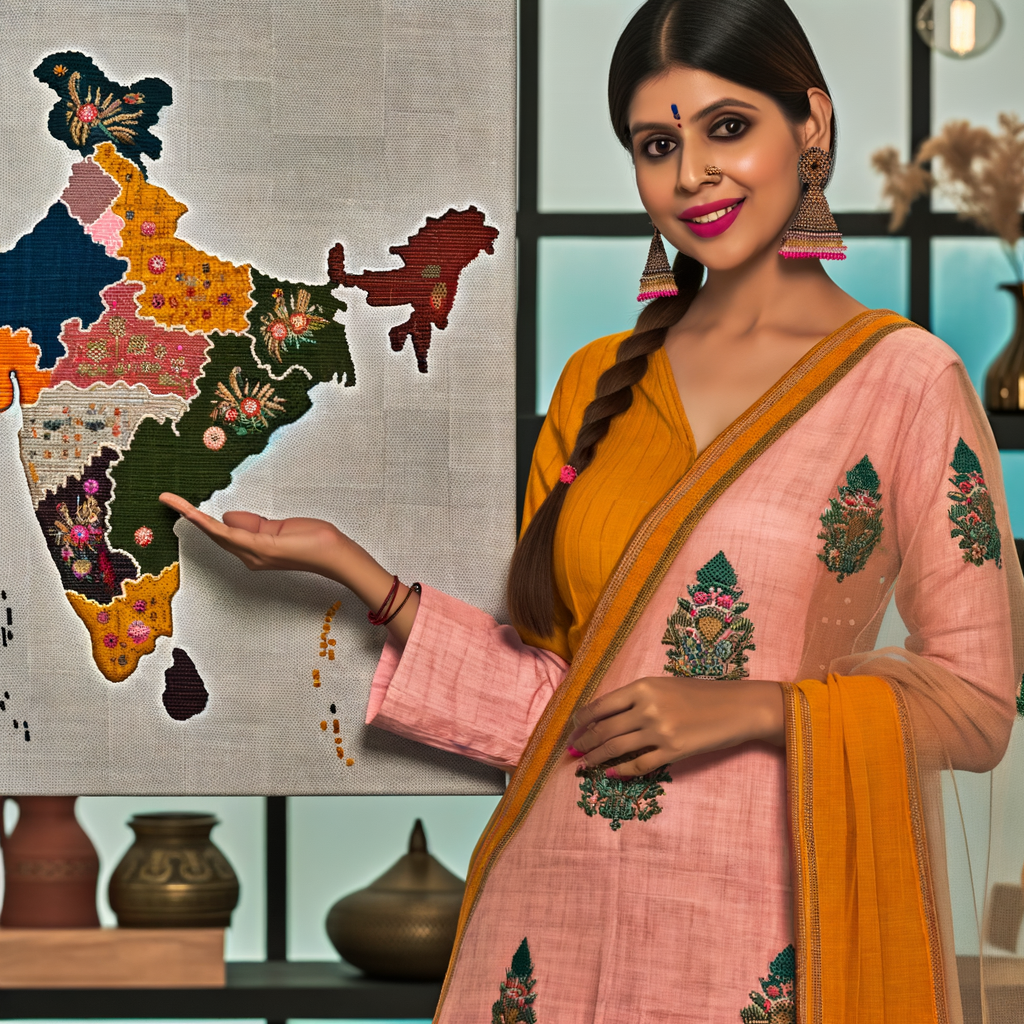
The Cultural Significance: Exploring the Regional Variations of Chikankari Art in India
Share
The Cultural Significance: Exploring the Regional Variations of Chikankari Art in India
Did you know that the delicate art of Chikankari, which today graces the ramps of Paris and Milan, was once whispered into existence by a Mughal queen in the royal courts of Lucknow? Yes, dear reader, this timeless embroidery is not just thread and fabric — it is poetry woven by nimble fingers, a living testament to India’s rich tapestry of traditional Indian crafts.
Today, let’s embark on a journey through the fragrant gullies of Lucknow, the bustling bazaars of Delhi, the artistic enclaves of Hyderabad, and beyond, as we explore the regional variations in Chikankari and uncover the cultural significance of Lucknow art that continues to enchant the world.
The Royal Birth of Chikankari: A Glimpse into the History of Indian Embroidery
In the heart of Awadh, under the soft golden light of the Mughal era, Chikankari was born. Legend has it that Empress Noor Jahan, a patron of arts, introduced this ethereal embroidery to India. Over centuries, it evolved, absorbing the flavors of every region it touched, becoming a jewel in the history of Indian embroidery.
Chikankari, derived from the Persian word 'Chikan' meaning embroidery, was initially done with white thread on muslin cloth, symbolizing purity and elegance. As it traveled across India, it embraced new colors, fabrics, and motifs, reflecting the soul of each region.
Lucknow: The Undisputed Heartbeat of Chikankari
When one speaks of Chikankari, Lucknow’s name rises like the fragrance of fresh ittar on a summer evening. The cultural significance of Lucknow art is deeply intertwined with Chikankari, where every stitch tells a story of Nawabi grandeur and poetic finesse.
Signature Styles of Lucknowi Chikankari
- Shadow Work (Bakhiya): The hallmark of Lucknowi Chikankari, where stitches are done on the reverse side, creating a shadow-like effect on the front.
- Phanda and Murri: Tiny knots and grains that add texture and depth, much like pearls scattered on moonlight.
- Jaali Work: A delicate mesh created by skillfully pulling apart threads without cutting the fabric — a marvel of patience and precision.
At thechikanstore.com, we proudly bring you authentic Lucknowi Chikankari, crafted by artisans whose lineage traces back to the royal ateliers of Awadh.
Delhi: The Modern Muse of Chikankari
As the capital city embraced Chikankari, it infused it with a contemporary spirit. Delhi’s version of Chikankari is a beautiful amalgamation of tradition and trend, making it a favorite among the fashion-forward crowd.
Characteristics of Delhi Chikankari
- Vibrant Colors: Unlike the traditional whites, Delhi artisans experiment with bold hues like fuchsia, turquoise, and emerald.
- Fusion Fabrics: Chikankari on georgette, chiffon, and even denim — a nod to modern sensibilities.
- Contemporary Motifs: Alongside traditional paisleys and florals, you’ll find abstract patterns and geometric designs.
This regional variation in Chikankari reflects the evolving tastes of urban India while staying rooted in the traditional Indian crafts ethos.
Hyderabad: The Pearl City’s Love Affair with Chikankari
In Hyderabad, where pearls glisten and biryani simmers, Chikankari found a new home. The city’s royal past and cosmopolitan present gave rise to a unique style of Chikankari that is both regal and relaxed.
Hyderabadi Chikankari Highlights
- Rich Fabrics: Silk, organza, and fine cotton dominate, adding a luxurious touch to the embroidery.
- Jewelled Embellishments: Pearls, sequins, and beads often accompany the stitches, echoing Hyderabad’s famed opulence.
- Floral Extravaganza: Large, bold floral patterns dominate, inspired by the Mughal gardens and Deccan flora.
Hyderabad’s interpretation of Chikankari is a perfect example of how different styles of Chikankari adapt to regional aesthetics while preserving the soul of the craft.
Kolkata: The Artistic Soul of Chikankari
In the cultural cauldron of Kolkata, Chikankari found yet another avatar. Here, the art form is celebrated for its subtlety and sophistication, much like the city’s love for Rabindra Sangeet and adda sessions.
Kolkata’s Chikankari Charm
- Pastel Palette: Soft pinks, mint greens, and ivory dominate, reflecting Bengal’s love for understated elegance.
- Minimalistic Designs: Less is more — delicate vines, tiny flowers, and minimal motifs rule the scene.
- Handloom Fusion: Chikankari on Bengal handloom fabrics like khadi and muslin creates a unique, breathable luxury.
This regional variation in Chikankari beautifully marries the history of Indian embroidery with Bengal’s artistic temperament.
Jaipur: The Royal Rhapsody of Chikankari
In the pink-hued lanes of Jaipur, Chikankari dances to a royal tune. The city’s love for grandeur and color breathes new life into this ancient craft.
Jaipuri Chikankari Features
- Bold Contrasts: Bright embroidery on vibrant backgrounds — think mustard on magenta, or turquoise on coral.
- Block Print Fusion: Chikankari often paired with traditional Rajasthani block prints, creating a visual symphony.
- Mirror Work: Tiny mirrors stitched into the fabric add a festive sparkle, perfect for celebrations.
Jaipur’s take on Chikankari is a celebration of life itself, a colorful testament to the enduring beauty of traditional Indian crafts.
Regional Variations in Chikankari: A Tapestry of Diversity
As we wander through the diverse landscapes of India, it becomes clear that Chikankari is not just an embroidery technique — it is a living, breathing art form that adapts, evolves, and thrives. Each region adds its own flavor, creating a rich mosaic of different styles of Chikankari that together narrate the story of India’s artistic soul.
Key Regional Influences on Chikankari
- Fabric Choices: From Lucknow’s muslin to Hyderabad’s silk, the base fabric transforms the final look.
- Color Palettes: Whites and pastels in the east, vibrant hues in the west and north.
- Motif Inspirations: Mughal gardens, Deccan flora, Rajasthani palaces, and Bengali minimalism.
- Technique Innovations: Traditional hand embroidery, fusion with block prints, and embellishments with pearls and mirrors.
Understanding these regional variations in Chikankari deepens our appreciation for the craft and highlights the cultural significance of Lucknow art as its beating heart.
Preserving the Legacy: The Role of thechikanstore.com
At thechikanstore.com, we are not just selling clothes; we are preserving a legacy. Every kurta, saree, and dupatta you find with us carries the whispers of history, the fragrance of tradition, and the dreams of artisans who have dedicated their lives to this exquisite craft.
We work directly with master artisans from Lucknow and other regions, ensuring that every piece you wear is authentic, sustainable, and steeped in the rich history of Indian embroidery.
Conclusion: Wrap Yourself in a Story
Chikankari is not just fashion; it is a feeling. It is the soft caress of muslin on a summer day, the intricate dance of needle and thread under a moonlit sky, the silent poetry of a craft that has survived empires and eras.
When you wear Chikankari, you don’t just wear a garment — you wear a story, a legacy,

